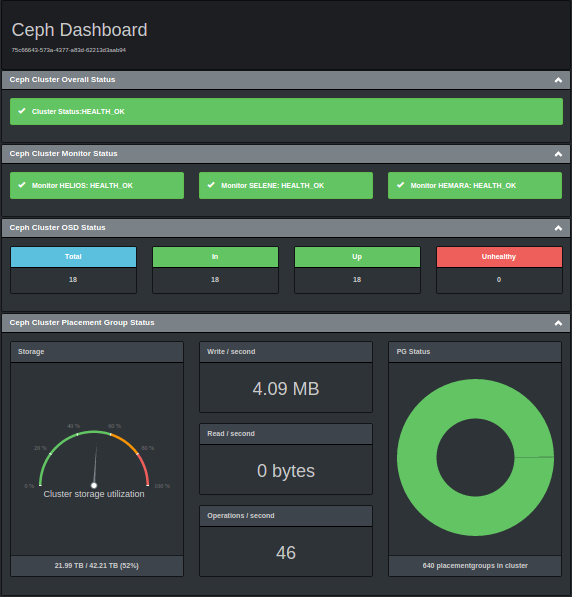ceph-dash
Having recently finished to re-install my cloud environments, I am now focusing on setting back up my supervision and monitoring services.
Last week, a friend of mine (Pierre-Edouard Gosseaume) told me about his experience with ceph-dash, a dashboard for Ceph I hadn’t heard from back then.
Like most ceph users, I’ve heard of Calamari. A languages, frameworks and technologies orgie I’ve ended up building by myself, and deploying on a test cluster I used to operate in Smile.
Calamari is sort of a fiasco. The whole stack gets fucked up by the underlying component: Saltstack.
Saltstack is yet another configuration deployment solution such as Puppet, Ansible or Rundeck.
Using Calamari, the calamari-server instance would use saltstack to communicate with its clients. As far as I could see, saltstack service randomly stops running on clients, until no one is responding to our server queries. A minute-based cron is required to keep your queries somewhat consistent. It’s a mess, I’ve never installed calamari on a prod cluster, and would recommend waiting at least for some pre-packaged release.
So, back to ceph-dash.
My first impression was mitiged, at best. Being distributed on github, by some “Crapworks“, I had my doubts.
On second thoughts, you can see they have a domain, crapworks.de. Deutsche kalität, maybe germans grant some hidden meaning to the crap thing, allright.
Again, there’s no package shipped. And as of Calamari, ceph-dash makefile allows you to build deb packages.
Unlike Calamari, ceph-dash is a very lightweight tool, based mostly on python, inducing low overhead, and able to run fully deported of your ceph cluster.
Even if the documentation tells you to install ceph-dash onto a MON host of your cluster, you may as well install it to some dedicated VM, as long as you do have installed the right librados, have a correct /etc/ceph/ceph.conf, and can use a valid keyring accessing the cluster.
ceph-dash ships with a small script running your service for tests purposes. It also ships with the necessary configuration for Apache integration, easily convertible to Nginx.
The zero-to-dashbord is done in about 5 minutes. Which again, is vastly different from my experience with Calamari.
The major novelty being, it actually works.
